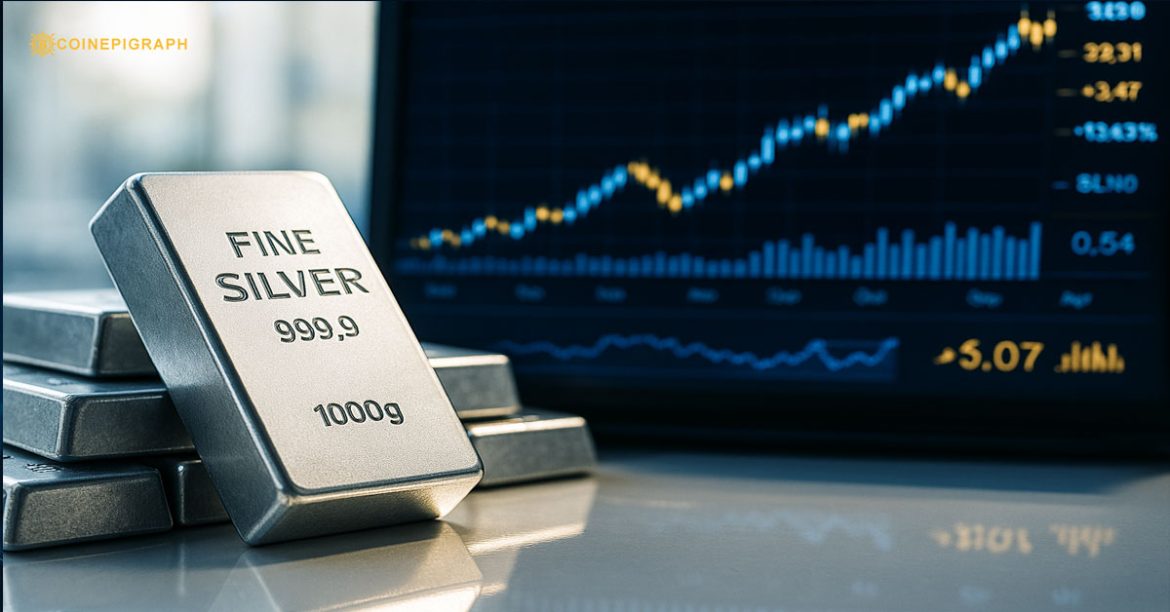By CoinEpigraph Editorial Desk | October 16, 2025
Silver’s rally is turning into a structural story. What began as a quiet climb has erupted into a historic supply squeeze that traders compare to the legendary Hunt Brothers episode of 1980. With inventories collapsing in London and futures markets flashing stress, the white metal has become the latest battlefield between industrial demand and speculative leverage.
Physical scarcity meets financial pressure
In recent weeks, London Bullion Market Association (LBMA) data showed vault holdings falling to their lowest levels in modern records. Refiners in Switzerland and Asia are running at capacity, with some dealers reportedly flying metal to satisfy industrial contracts. The premium between physical delivery and futures contracts has widened sharply — a classic sign of shortage.
Silver has surged past $50 an ounce in intraday trading, briefly eclipsing levels that traders once thought untouchable. The rally has outpaced gold on a percentage basis, a rare feat that underscores just how violently positioning has shifted.
What’s driving it isn’t just investor enthusiasm — it’s mechanics. Short sellers, particularly leveraged funds that used futures to bet on mean reversion, are being forced to unwind positions as prices accelerate. The result is a self-reinforcing loop: buying to cover drives prices higher, which forces more buying to cover.
Industrial demand adds fuel
Silver’s unique role in the modern economy amplifies its volatility. Roughly half of annual demand comes from industrial uses — solar panels, electric vehicles, medical devices, and high-end electronics. That demand is inflexible. Manufacturers can’t easily substitute other metals, and green-energy infrastructure consumes ever-greater quantities.
This dual identity — monetary refuge and industrial necessity — makes silver unusually sensitive to both inflation expectations and supply bottlenecks. When both move in the same direction, the market can experience explosive repricing.
Analysts divide on what happens next
Bank of America raised its short-term silver forecast to $65, arguing that industrial restocking and investor hedging could keep the rally alive through year-end. Others, like Goldman Sachs, caution that silver lacks gold’s institutional safety net; central banks rarely buy it, and retail traders dominate liquidity.
That makes the metal prone to violent reversals. If speculative long positions grow too crowded or macro data cools inflation expectations, silver could just as easily drop $10–15 in a week.
Still, the structural setup remains remarkable. Physical tightness has persisted for months, and mine output has failed to keep pace with industrial offtake. The longer inventories stay depressed, the more the squeeze narrative resonates.
Echoes of 1980 — and of today’s digital crowd
Comparisons to the Hunt Brothers’ 1980 squeeze — when two Texas oil magnates tried to corner the silver market — are inevitable, but the modern version is decentralized. There’s no single villain; rather, the “crowd trade” dynamic of social media, retail communities, and algorithmic models amplifies moves that once took weeks into hours.
This year’s rally also overlaps with broader distrust in monetary policy. As rate cuts loom and debt ratios climb, investors are gravitating toward tangible stores of value — gold, silver, even Bitcoin — assets that can’t be printed. That emotional current gives the metal’s momentum a psychological undertone beyond simple supply-demand math.
What to watch now
The next few weeks will decide whether this was a temporary squeeze or the start of a new price regime. Key indicators to monitor:
- Vault withdrawals in London and COMEX
- Lease rates (reflecting borrowing scarcity)
- Spread between spot and futures prices
- Industrial order backlogs in solar and EV sectors
If those signals remain tight, the metal could remain elevated even after short covering subsides.
👉 “The CoinEpigraph Bottom Line”
Silver’s surge isn’t just a story about traders caught off guard; it’s a glimpse into how fragile physical markets can become when financial leverage collides with real-world scarcity. Whether or not prices hold above $50, the episode reminds markets that tangible assets — from metals to mined resources — still anchor the global economy.
The “poor man’s gold” may no longer be poor. It might just be the loudest warning siren in today’s liquidity-driven world.
At Coinepigraph, we pride ourselves on delivering cryptocurrency news with the utmost journalistic integrity and professionalism. Our dedicated team is committed to providing accurate, insightful, and unbiased reporting to keep you informed in the ever-evolving crypto landscape. Stay tuned as we expand our coverage to include new sections and thought-provoking op-eds, ensuring Coinepigraph remains your trusted source for all things crypto. -Ian Mayzberg Editor-in-Chief
The team at CoinEpigraph.com is committed to independent analysis and a clear view of the evolving digital asset order.
To help sustain our work and editorial independence, we would appreciate your support of any amount of Bitcoin/Satoshi to this address below: 3NM7AAdxxaJ7jUhZ2nyfgcheWkrquvCzRm
and through our Support Page.
🔍 Disclaimer: CoinEpigraph is for entertainment and information, not investment advice. Markets are volatile — always conduct your own research.
COINEPIGRAPH does not offer investment advice. Always conduct thorough research before making any market decisions regarding cryptocurrency or other asset classes. Past performance is not a reliable indicator of future outcomes. All rights reserved 2024-2025.




